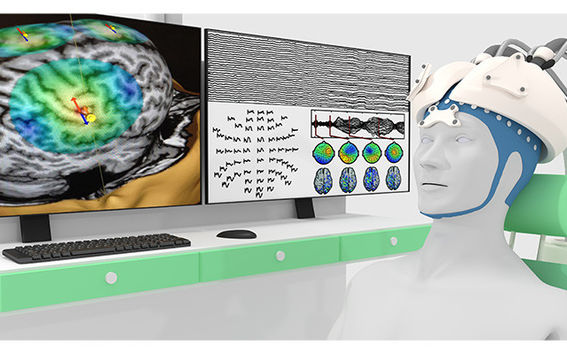One million euro for research on electromagnetic brain stimulation

The new project will involve Aalto University and the University of Eastern Finland working together to develop electromagnetic brain stimulation methods and the recording of brain activity that results from the stimulation.
The goal of Aalto University researchers is to produce a new kind of multi-channel transcranial magnetic stimulator, mTMS. Multi-channel transcranial magnetic stimulation is a method used to stimulate small regions of the brain. Using the stimulator, brain-activating pulses are directed electronically to their target areas based on simultaneously measured responses from the brain or muscles. Instead of using human judgement, the decision on the target, timing and strength of the next electromagnetic pulse is calculated using computer algorithms. In addition to enabling quick and feedback-dependent stimulation series that activate multiple brain regions, this method also allows the pulses to be coupled with the natural brain rhythms.
‘Controlled activation of entire neural networks improves the prospects of developing therapies for treating conditions such as stroke, chronic pain or depression,’ says Professor Risto Ilmoniemi while speaking of the opportunities presented by the project.
Potential benefits: Parkinson’s disease and chronic pain
In the A.I. Virtanen Institute at University of Eastern Finland, Professor Olli Gröhn’s research group is developing methods for measuring stimulation-induced activation using functional magnetic resonance imaging. In addition, multi-channel electric stimulation allowing electronic control of orientation of electrical fields is being developed. This will enable in the future better target selection for brain stimulation. The potential benefits include increased efficacy, and reduced side effects, of deep brain stimulation treatments of conditions such as Parkinson’s disease and chronic pain. The project is performed in collaboration with Associate Professor Shalom Michaeli from University of Minnesota.
In Otaniemi, new magnetic stimulators will be constructed to be used in a human 3-tesla magnetic resonance imaging (MRI) scanner, and in a small-animal 9.4-tesla MRI device at the University of Eastern Finland.
At Aalto University, the technical groundwork for the project has been carried out by Risto Ilmoniemi, Academy Research Fellow Jaakko Nieminen, postgraduate students Lari Koponen, Tuomas Mutanen and Aino Tervo, University Lecturer Matti Stenroos and Erasmus Visiting Doctoral Candidate Victor Hugo Souza from Brazil. In addition, National Taiwan University Professor Fa-Hsuan Lin, a long-term partner of the Department of Neuroscience and Biomedical Engineering and a former visiting FiDiPro fellow, provides MRI expertise for the project.
The name of the grant-winning project is ‘a new era in brain stimulation: development of next-generation EEG/fMRI compatible multi-channel brain stimulation technology.’ The size of the grant is 1 085 000 €, of which Aalto University will receive 643 000 € and the University of Eastern Finland will receive 442 000 €.
Further information:
Risto Ilmoniemi
Professor
Aalto University
risto.ilmoniemi@aalto.fi
tel. +358 50 556 2964
Olli Gröhn
Professor
A.I. Virtanen Institute
University of Eastern Finland
olli.grohn@uef.fi
tel. +358 50 359 0963
Read more news

Your voice gives away valuable personal information, so how do you keep that data safe?
With speech technologies becoming increasingly common, researchers want to make sure we don’t give away more information than we mean to.
A new way to measure contagion: the gut bacterium behind blood poisoning can spread like influenza
Neither the antibiotic-resistant nor the highly virulent strains are the most transmissible.
Cross-sectoral working group: Competitiveness, security and green transition must be promoted as a whole
A cross-sectoral working group for universities, businesses and cities is proposing that Finland speed up its international competitiveness, national security and green transition as one entity. The group suggests that, for example, defence procurement could support solutions aimed at a carbon-neutral society.






